Horizon Hobby E-flite Cirrus SR22T 1.5m BNF Basic
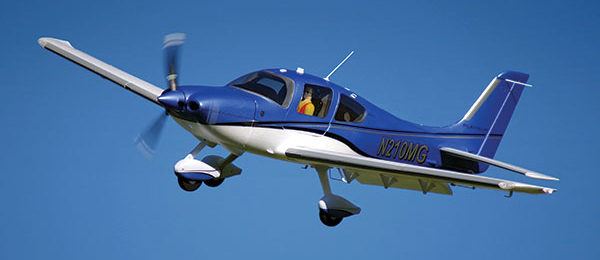
Written by Jon Barnes An enjoyable and forgiving civilian sport model Product Review As seen in the July 2018 issue of Model Aviation.
Specifications
Model type: Semiscale foam electric Skill level: Intermediate Wingspan: 59 inches Wing area: 369 square inches Length: 39 inches Weight: 53 to 61 ounces Power system: Brushless electric Radio: Minimum six-channel Spektrum-compatible required Construction: EPO foam Price: $229.99Test-Model Details
Power system: E-flite 10-size 1,300 Kv brushless (included); E-flite 40-amp ESC (included); E-flite 3S 2,200 mAh LiPo battery Propeller: Three-blade 11 x 7.5 (included) Radio system: Spektrum DX9 transmitter; Spektrum AR636A receiver (included) Ready-to-fly weight: 54 ounces Flight duration: 6 to 10 minutesPluses
• SAFE and AS3X technologies help to make this model accessible to newer pilots. • Battery is positioned near the CG, allowing pilots to easily use larger-capacity packs to extend flight duration. • Scalelike navigation lighting, wingtip strobes, interior cabin light, and landing lights. • Gapless Fowler flaps enhance slow-speed departures and arrivals. • Wing halves utilize hands-free system to simplify servo connections. • Numerous plastic scale bits and pieces enhance realistic inflight appearance.Minus
• Gaps to the front and rear of the removable canopy hatch are slightly larger than typical.Bonus Video
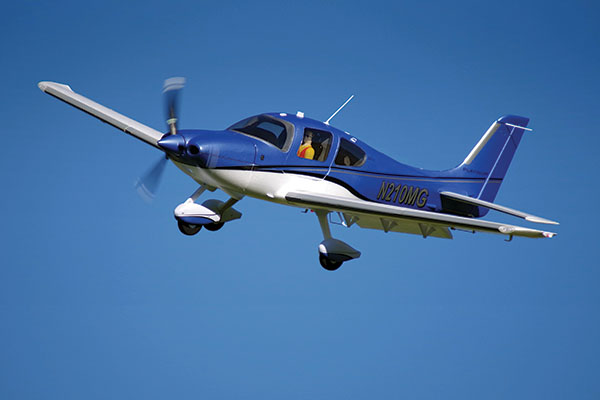
With SAFE mode activated and the flaps deployed to the landing position, this model will practically land itself.
Product Review
Originally founded in 1984, the Cirrus Aircraft Corporation is a relative newcomer to the decades-old world of general aviation airplane design and manufacturing. Its first notable success was the Cirrus SR20, a piston engine-powered, composite-construction monoplane that made its first flights in 1995. This sleek airplane’s standout design features include a Garmin-based glass cockpit and a full-size parachute that can be deployed to lower the entire airplane safely to the ground in the event of a variety of potential inflight emergencies. In 2001, a more powerful and updated version of the SR20 was released. Christened the SR22, this second-generation airplane features a larger wing and increased fuel capacity. It remains the only production aircraft in its class to utilize side stick-style primary flight controls. The Cirrus’ SR series of aircraft has proven to be wildly successful, qualifying as the world’s best-selling general aviation airplane every year since 2002! E-flite acknowledges the noteworthy popularity of the thoroughly modern and technology-laden Cirrus SR22T within the general aviation community with the release of an electric-powered, 1.5-meter wingspan, foam-composition BNF model (a Plug-N-Play version is also available). This scale replica of the SR22T is officially licensed from Cirrus and captures much of the advanced elegance of the full-scale aircraft. Modelers unpacking this kit from the box will first notice the authentic and attractive blue, white, and silver paint scheme. The blue paint used by E-flite to finish this foam model possesses an almost metallic-looking sheen.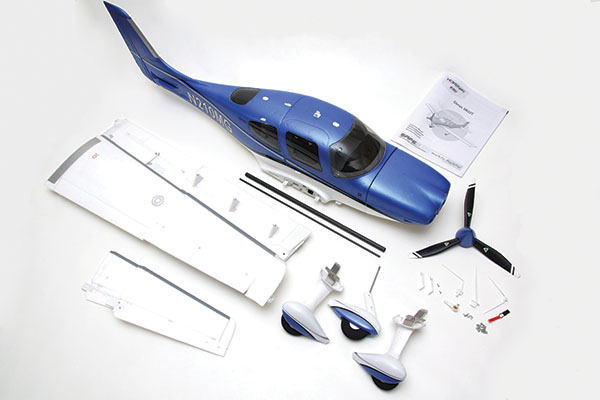
The blue paint used on this foam aircraft is uniquely pearlescent and nicely recreates an authentic general aviation scheme.
A full set of factory-installed lights includes red and green wingtip-mounted navigational lights and white strobes, a flashing red strobe located on the underside and aft portion of the fuselage, and a cowl-mounted white LED landing light. A white LED is also mounted inside of the fuselage and slightly aft of the removable hatch. It creates a faint glow that not only subtly illuminates the model’s cabin interior, but casts a convenient amount of light into the battery bay during pack swaps. This model includes flaps and a set of sturdy, fixed, tricycle landing gear with plastic wheel pants. Many models in this size and price class use simple foam hinges on the flaps, but the E-flite Cirrus features a gapless Fowler-style flap that utilizes a more-durable style of plastic hinges. Pilots must provide a minimum six-channel, Spektrum-compatible, full-range receiver and a three-cell 2,200 to 3,000 mAh LiPo battery.
Assembly
When assembling this model, pilots can leave all of their adhesives on the bench. Similar to most modern foam kits, the Cirrus goes together with a handful of small metal fasteners. Embedded servo connections at the wing roots and on the fuselage automatically align as the long, slender wing halves slide into place. This unique feature greatly simplifies assembly/disassembly for both transport and storage. It also effectively eliminates any chance of making erroneous servo connections when assembling the model at the field in preparation for flight.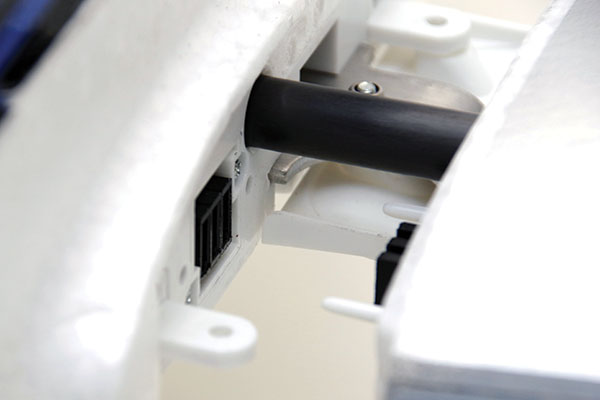
Flap and aileron servo connections are embedded in the wing roots, simplifying wing removal and attachment.
A handful of plastic pieces nicely enhance the aircraft’s scale outline. Pilots will appreciate that they are all attached to the airframe using small screws. Using fasteners instead of glue enables easy replacement in the event that these scale details become damaged while transporting or storing the model. Most pilots will require roughly the same amount of time to program their Spektrum-compatible transmitter as they will need to assemble the model. The assembly manual provides all of the required programming information, with the settings for 12 current and legacy Spektrum transmitters mapped out in an easy-to-read matrix. The embedded Sensor Assisted Flight Envelope (SAFE) technology must be activated or disabled during the binding process. Pilots who elect to fly with this technology enabled will also then need to select and program a SAFE mode switch on their transmitters to be able to enable and disable the technology at will and while in flight.
Flying
The Cirrus’ flight battery is easily accessible, thanks to an oversize, removable, magnetically retained hatch. With the hatch removed, the entire center section of the fuselage is open and accessible to pilots. Models are typically designed so that the battery must be placed all the way forward in the fuselage in order to attain the recommended center of gravity (CG). This often results in the battery being difficult to secure in place and to remove. Not so with the SR22T! The Cirrus’ midship battery placement, located near the recommended CG, makes the battery easily accessible. This also allows pilots to easily experiment with flight duration by using larger-capacity packs. Slipping a slightly larger three-cell 3,000 mAh LiPo battery inside of the Cirrus can potentially allow pilots to remain aloft for 10 minutes and longer!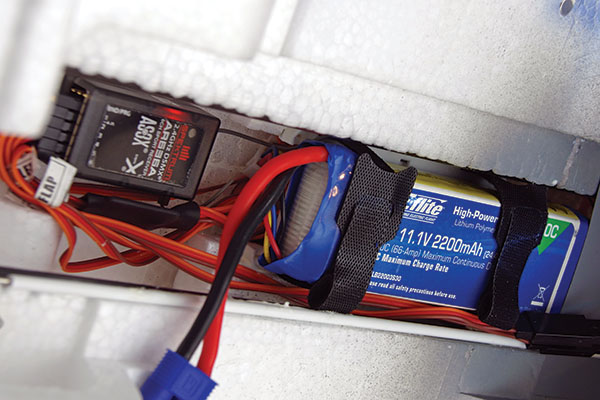
The battery tray is located almost directly on top of the recommended CG, allowing pilots to easily extend fight durations by going with a higher-capacity pack.
One small complaint involves the slightly large gaps that exist at both the front and rear edges of the removable canopy hatch when they are mounted in place on the fuselage. These gaps slightly detract from the otherwise stunning profile and appearance of this modern model. The Cirrus uses fixed tricycle-configuration landing gear. The main gear’s relatively wide stance makes for a model that tracks nicely during the takeoff roll. With the SAFE mode activated and the throttle restricted to more moderate settings, this low-wing aircraft can even be flown by pilots who are relatively new to the hobby. The long, slender wing of this model and wide, flat fuselage effectively create an abundance of lifting area. With the almost gapless Fowler-style flaps deployed, this airplane’s slow-speed performance envelope is impressive. Approaches and landings can be executed in a scalelike manner. Shooting touch-and-gos with the Cirrus is in fact so enjoyable that pilots might find themselves content to remain in the pattern for the entire flight. With SAFE mode off and the power quadrant pushed full forward, the Cirrus becomes an agile, aerobatics-capable airplane. Those who prefer even more power behind the scalelike three-blade propeller might want to explore flying this model with a four-cell LiPo battery. The caveat in doing so is that the manufacturer does not officially recommend that this model be flown on anything other than a three-cell pack. It is also difficult to discern if the included 40-amp ESC is technically even rated for four-cell operation because neither the ESC’s label nor the manufacturer’s online specifications offer the typically available acceptable range of LiPo battery voltage and cell count that can safely be connected to this brushless ESC. With the aforementioned cautions thrown to the wind, and a four-cell 2,200 mAh pack belted securely in place, the Cirrus SR22T is transformed into an even more impressive and notably higher-performance model. Vertical uplines flown at wide-open throttle on a four-cell pack can be sustained long enough to test pilots with even the best visual acuity! With the flaps deployed to the landing position, the combination of SAFE mode and AS3X stabilization allow this model to be paraded around the skies at an incredibly slow and stable pace.
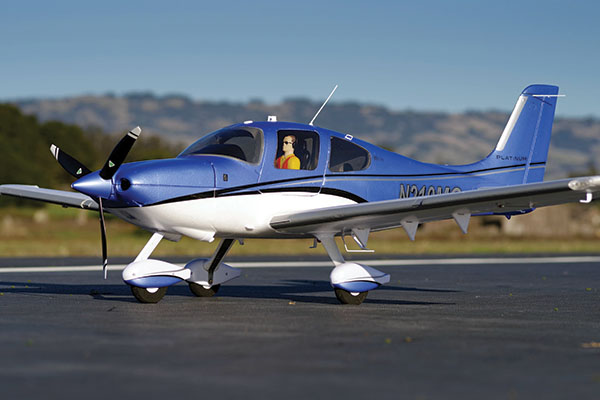
Fowler flaps and a full set of navigation/landing lights make this aircraft one that can be flown off of shorter runways and in varied lighting conditions.
I found myself continuing to fly well past sunset. The model’s full array of lights enhance in-flight orientation so well that pilots will be able to fly their Cirrus on into the darkening skies of twilight.
Conclusion
Those who particularly favor the general aviation sector will agree that this genre is not as well represented as some of the other categories of model aircraft. The E-flite Cirrus SR22T offers pilots with more than a passing interest in the category an attractive and versatile general aviation model that, thanks to the embedded SAFE and AS3X technologies, can be flown and enjoyed by pilots of almost any skill level. Standout features include the comprehensive lighting system, gapless Fowler flaps, and the ability to easily use larger-capacity battery packs for impressively long flights. Should pilots require any replacement components or spare parts, a matrix, complete with part numbers, is included in the rear of the assembly manual.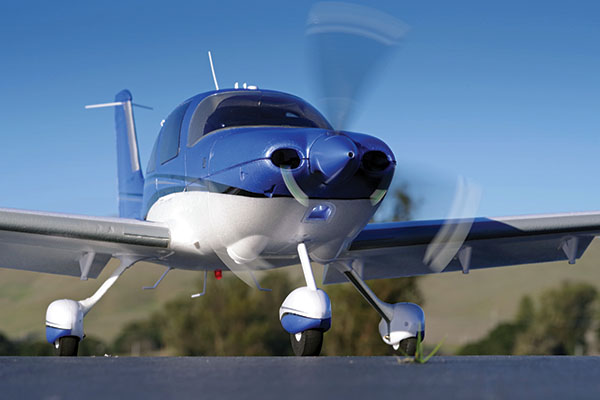
The three-blade propeller and assortment of scale details combine to make the Cirrus look authentic from almost any angle.
—Jon Barnes [email protected]










1 comments
Review
Add new comment